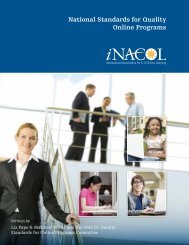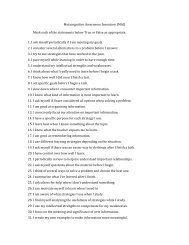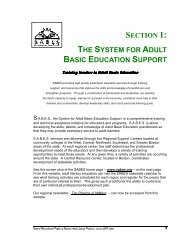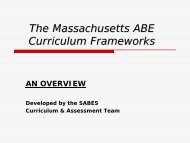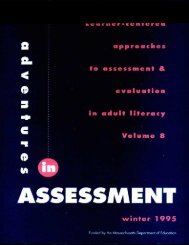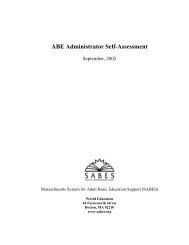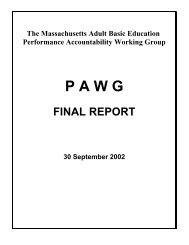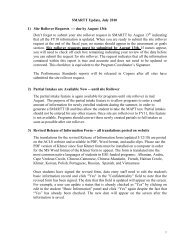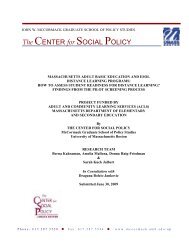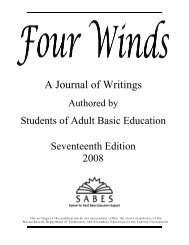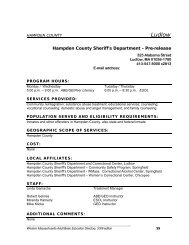Integrating Career Awareness into the ABE/ESOL Classroom - SABES
Integrating Career Awareness into the ABE/ESOL Classroom - SABES
Integrating Career Awareness into the ABE/ESOL Classroom - SABES
- No tags were found...
You also want an ePaper? Increase the reach of your titles
YUMPU automatically turns print PDFs into web optimized ePapers that Google loves.
credit hour<br />
co-requisite classes<br />
developmental courses<br />
elective course<br />
faculty<br />
interdisciplinary course<br />
Major<br />
mandatory/requisite class<br />
online course<br />
prerequisite class<br />
survey course<br />
syllabus<br />
TYPES OF EDUCATIONAL<br />
INSTITUTIONS<br />
private college or university<br />
public college or university<br />
proprietary school<br />
expect students to take a placement test after <strong>the</strong>y<br />
have been accepted at <strong>the</strong> school.<br />
The number of credit hours per course usually<br />
represents <strong>the</strong> number of class hours per week.<br />
two or more classes that are required to be taken<br />
simultaneously<br />
These help students brush up on basic skills like<br />
reading, writing, and math so students will be prepared<br />
for college-level work. Most schools do not offer credit<br />
towards a degree for <strong>the</strong>se classes.<br />
a course a student takes by choice, as distinguished<br />
from a course specifically required by a degree<br />
<strong>the</strong> teachers and professors at a school or college<br />
a course dealing with two or more academic<br />
subjects<br />
Called a concentration at some colleges, a major is<br />
<strong>the</strong> primary subject you choose to study in college.<br />
A majority (but not all) of your college courses will<br />
be related to your major.<br />
a class that is necessary in order to get your degree<br />
Sometimes referred to as web-based courses, <strong>the</strong>se<br />
are regular college credit classes utilizing technology,<br />
including <strong>the</strong> Internet, to deliver course information<br />
and material and to promote class discussion.<br />
a class that is required to be completed before a<br />
student may enroll in a higher-level class<br />
a course designed to provide a general overview<br />
of an area of study<br />
an outline of topics to be covered by <strong>the</strong> instructor<br />
including assignments to be completed by <strong>the</strong> students<br />
during <strong>the</strong> course<br />
a self-supporting institution of higher education<br />
operated with private funds<br />
an institution of higher education operated with state<br />
funds<br />
privately owned and operated post-secondary schools<br />
organized as ei<strong>the</strong>r non-profit or profit-making ventures<br />
primarily to teach vocational skills<br />
College Vocabulary 101 • Section IV: <strong>Career</strong> Planning Skills, Lesson 10 • Page 3<br />
<strong>Integrating</strong> <strong>Career</strong> <strong>Awareness</strong> <strong>into</strong> <strong>the</strong> <strong>ABE</strong> & <strong>ESOL</strong> <strong>Classroom</strong> | Section IV, Lesson 10: College Vocabulary 101 | 126



